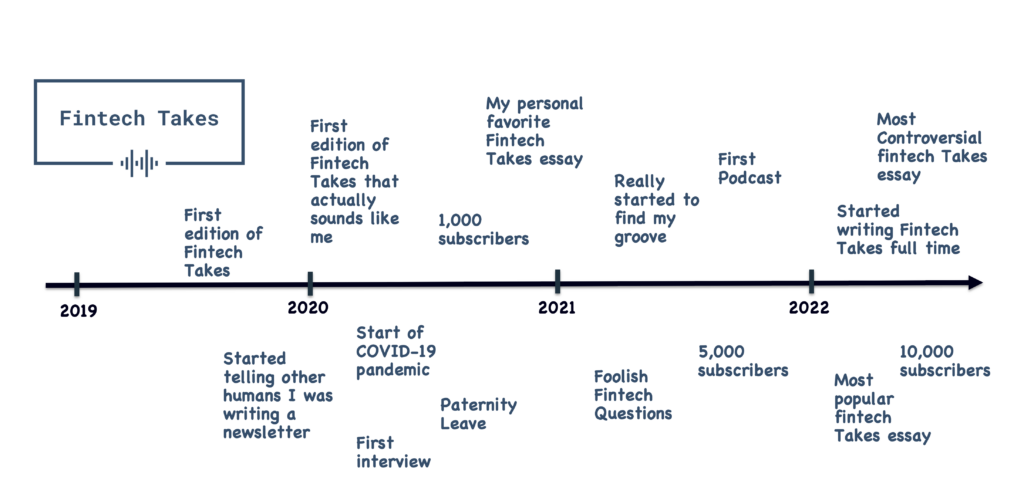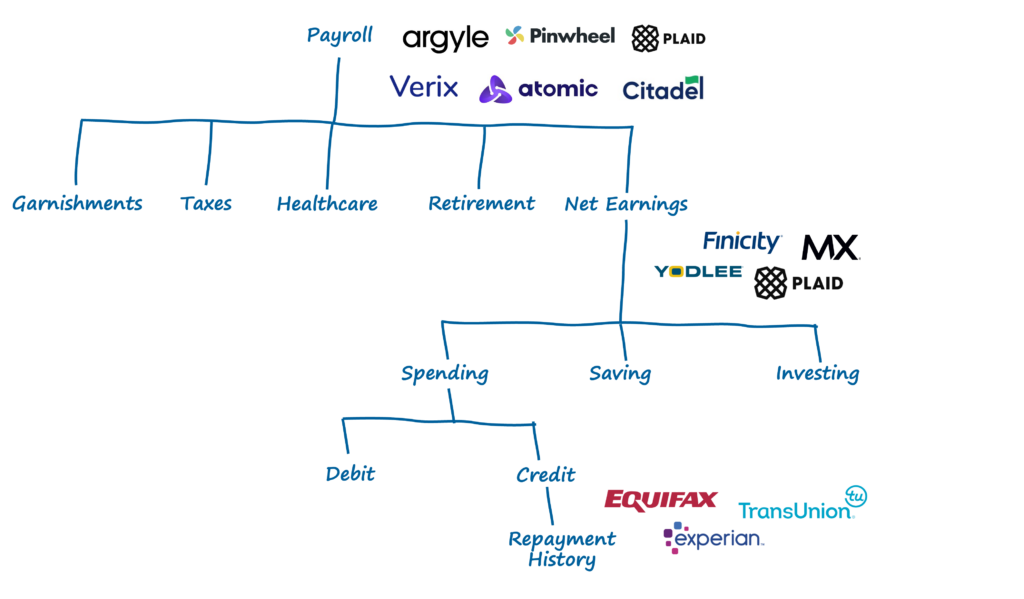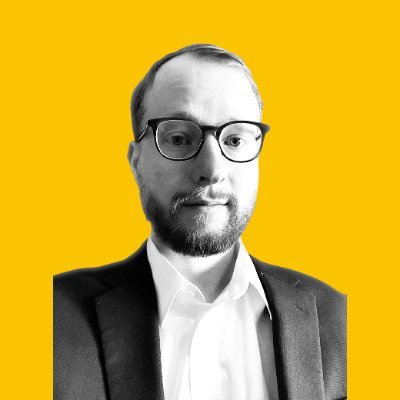226,929.
That’s the number of words I’ve written in this newsletter since I started it, just over three years ago.
I find that a bit staggering. It sometimes feels like I’ve been writing Fintech Takes for a decade. And other times it feels like I just got started. But 226,929 words? That’s a terrifyingly large and specific number, and it begs a question – what have I learned over the course of all of that writing?
Fintech Takes’ third birthday seems like as good an excuse as any to get a bit introspective, answer a few questions, and jot down a few lessons that I’ve learned over the last three years of trial and error.
But first, a little context.
Fintech Takes: A Brief History
I started writing Fintech Takes because, by September of 2019, I was seeing Substack newsletters popping up everywhere and I decided to see what all the fuss was about.
By January of 2020, I had come to the conclusion that, no matter what was going on in my personal life or in my day job (I was working at FICO at the time), I was going to make time to write the newsletter. The process of researching and writing the newsletter was forcing me to become a much keener observer and much sharper analyst of the fintech space, and I didn’t want to give that up.
This conviction persisted through the start of the pandemic (when I had a lot more time on my hands) and through paternity leave (when I had a lot less time), and by early 2021 I was really starting to find a good groove with my takes. I had gotten a new job where the newsletter was a more central part of my professional life (I am deeply grateful to Cornerstone Advisors for giving me that opportunity), and I was starting to expand the types of content I was creating (including podcasting!).
And then Adam Ryan and Becca Sherman (the co-founders of Workweek) reached out to me and asked if I had ever thought about writing the newsletter full-time and, since May of this year, that’s what I have been lucky enough to be doing.

Lessons Learned
And now, on to the lessons learned:
“Sometimes you have to play a long time to be able to play like yourself.”
That quote, from Miles Davis, is about playing the trumpet, but I’ve found it to be just as applicable to writing a newsletter.
My earliest newsletters bear very little resemblance to the ones I write today. They were much shorter and more referential. They often danced around the point I was trying to make, rather than just saying it outright.
I think the first one that actually sounds like me – an original (and somewhat controversial) take backed up by fairly deep analysis – is this one: The Stories We Tell Ourselves About Open Banking.
And still, it would take me another year to be able to write the piece that I consider my personal favorite essay.
The lesson? Figuring out how to create your best work, the work that only you could produce, takes a lot of reps.
Writing is like flossing.
Miguel Armaza asked on Twitter, “how do you stay consistent and how have you optimized your creation process?”
Sign up for Fintech Takes, your one-stop-shop for navigating the fintech universe.
Over 41,000 professionals get free emails every Monday & Thursday with highly-informed, easy-to-read analysis & insights.
No spam. Unsubscribe any time.
Everyone I know who creates content, either as their full-time job or as a passion project, struggles with producing consistently. Life gets in the way. If it’s a passion project, like Fintech Takes has been for me for most of its existence, work gets in the way. Staring at a blank screen and having no idea what you’re going to write about has to be one of the most frustrating and anxiety-inducing experiences that I’ve ever gone through.
And it never gets easy (or, at least, it hasn’t for me so far).
What has made it easier, though, is turning writing into a habit.
Much like flossing or exercise or meditation or anything else that’s important but not always instinctively enjoyable, I’ve found that the key to consistent and somewhat efficient content creation is cultivating it into a habit, a thing that becomes so much a part of your standard routine that it feels weird when you don’t do it.
My personal writing routine, when I’m on top of things, looks like this:
- 4-5 days before publication: Brainstorm ideas, ideally while doing some type of mindless physical activity like chopping wood.
- 2 days before publication: Outline the piece, build graphics, and do research to fill in all the gaps (this is my ‘crash my Mac because I have too many Chrome tabs open’ day).
- 1 day before publication: Carve out 3-4 hours of time with no distractions, make a cup of tea, and write.
- Publication day: Edit, format, and publish the piece.
Consistency is king.
Related to the lesson above, I really can’t stress enough how important consistency has been in building Fintech Takes.
Quick story – last year, I conducted an informal survey of some of my subscribers, asking them what they thought of the newsletter and how I could improve it. One of the questions I asked was “would you prefer that Fintech Takes be published more frequently?” This specific question was motivated by my anxiety that I wasn’t producing enough content.
A lot of people responded that they didn’t think the newsletter needed to be published more often, once per week was just fine.
Here’s the rub though – at the time, I was publishing Fintech Takes once every two weeks. The consistency with which I was publishing valuable content had given my subscribers the impression that I was publishing more frequently than I was.
When you deliver content consistently, you are giving your audience the confidence to build time into their schedules to consume it, to make it a part of their routine. Given how busy we all are and how much great content is out there, earning (and keeping) a place in people’s lives (and inboxes) is essential.
Be passionate.
It took me a solid 2 months of writing the newsletter before I felt comfortable sharing it with anyone. Sharing your thoughts with strangers on the internet is scary, I don’t care who you are or how much experience you have in your field.
One thing that helps is focusing on topics and ideas that you are passionate about. Jas Shah asked on Twitter, “was there an early piece you wrote that you thought ‘no matter what happens, no matter how many people read this, it’s great and needs to be shared’?”
Yes! There was! And it helped me get over my fear of sharing my content on LinkedIn and Twitter. It was my first essay on the strategic threat of big tech in banking – The Convenience Trap, which is a topic I was (and continue to be) very passionate about.
Indulge your curiosity.
Simon Taylor asked on Twitter, “How do you prioritize what to write about?”
I struggle with this one. I think most people who create content enjoy the experience of seeing their content be well received by people they respect (Simon is one of those people for me, BTW). We want to see our stuff be praised and widely shared.
The challenge for me is that it’s really hard to guess what people are going to like. Every time I try to guess what’s going to be popular – by looking at what others are writing about or what is in the news right now – the resulting content tends to be received poorly.
The only thing I’ve found that works is following my own curiosity. I don’t try to guess what other people are going to want to read. I focus on what I want to learn about. I pursue those topics, sometimes for years (I first wrote about mortgage servicing in December of 2019 and then again in August of 2021 and in May of 2022). And you know what? The resulting content is the stuff that does the best, sometimes in terms of raw pageviews and social shares and sometimes in terms of the depth of engagement that certain readers have with the content.
People can always tell when you are writing about something you aren’t interested in.
Say it.
I try very hard not to have the hottest take solely to have the hottest take. I also try extremely hard never to be mean in the newsletter.
However, I have found that much of my best content, and the content that I am most personally proud of came out of a willingness to say the things that everybody is thinking but not saying.
It takes a while to develop a good feel for this, but once you have it down it can become a superpower.
Cross-sell is the root of most evils in banking. Self-driving money is probably impossible. Credit cards are an elaborate experiment designed to torture human beings. Venture-backed unicorns are boring. Neobanks aren’t software companies, they’re banks. BNPL is the new overdraft. When How? preempts What? In financial services, people get hurt. Your mission doesn’t matter if you pick the wrong business model. Fintech is breaking the credit bureaus.
Say what everyone else is thinking.
Being wrong is only a problem if you are uninterested in learning.
Another superpower is retraining your brain to be happy to be wrong.
This is not easy. When we hear “hey, you’re wrong about this,” our brains automatically translate that to “hey, you’re a complete moron and unworthy of any respect or attention”.
Feedback (even when it is delivered with great care) feels like an attack.
This is why creating content is scary. If you do it for more than 5 minutes, you are going to get something wrong. No matter how smart you are or how much research you do, you will get stuff wrong. And you will hear about it.
In three years, I have gotten a ton of stuff wrong. For just one example, check out my 20 fintech predictions for 2020. I think at least 13 of them were way off. And I won’t even bother trying to go back and count up all of the factual mistakes and simple errors I have made in the newsletter (there are far too many).
The way I cope with this embarrassment is to view all of these mistakes and bad guesses as opportunities to learn.
Vulnerability builds community.
The other benefit of being open to being wrong is that by showing vulnerability, I can start to foster a sense of community around the newsletter.
Another way that I have tried to do this is by periodically publishing what I call “foolish questions” that I have about fintech and financial services. I have done this twice so far (see Part 1 and Part 2), and I’m likely going to publish Part 3 before the end of this year (email me if you have any questions you’d like to have included!)
My long-term goal is to make Fintech Takes the home for the most curious people working in financial services. To do that, I have to go first and be willing to look dumb.
Pictures are worth far more than 1,000 words.
During the sessions at Money Experience Summit this week (which were excellent), I was very pleased to see this graphic appear a couple of different times:

I created this graphic for a piece I wrote on payroll data and fintech more than a year ago.
This is not a graphic that professional graphic designers would give any awards to (massive understatement). It’s not especially complex or detailed. But it does convey an important idea clearly – programmatic access to payroll data gives financial services providers insights that they’ve never had before.
When I started writing Fintech Takes, I didn’t plan on building my own graphics. However, what I have found (starting with this essay) is that by forcing myself to express my ideas about complex topics in simple (somewhat childish-looking) graphics, I can more clearly convey the heart of the ideas.
Today, most of my essays start out as graphics scribbled in my notebook.
Don’t ever rank company logos.
People will get mad, no matter how well-considered the rankings are. Trust me on this.
Be human.
I frequently get asked – what exactly does Workweek do?
My simple answer is that Workweek is a B2B media company built on the premise that humans prefer consuming business content that was obviously created by other humans.
I think this premise is brilliant, which is a large part of the reason why I joined Workweek (the other big part is that the people working here are fantastic).
One of the joys of consuming content from great creators is the feeling that you get, slowly over time, that you know how they are feeling when they are creating the content. When I read Matt Levine on Elon Musk, I can almost see him in my head, sighing resignedly at how dumb this all is. When I listen to a Zach Lowe podcast where he is talking about some dysfunctional NBA team, I can almost predict all the jokes he is going to make before he makes them.
On the surface, Fintech Takes is about the collision of financial services and technology. Under the surface, if you’ve been reading carefully and for a long enough time, it’s also about obscure movie references, reasons why you shouldn’t move to Montana, and an excessive fondness for analogies.
People come for the analysis. They stay (I hope) for the human behind the analysis.
Content creation isn’t a zero-sum game.
Tal Schwartz asked on Twitter, “with all the awesome fintech newsletters out there, how do pick your niche?”
Tal is right. There is an absolutely overwhelming number of fantastic fintech thinkers and content creators out there, including but absolutely not limited to: Ron Shevlin, Jason Mikula, Simon Taylor, Nicole Casperson, Nik Milanovic, Michael Jenkins, Marc Rubinstein, Lex Sokolin, Reggie Young, Matt Janiga, Samir Rao, Matt Goldman, Chris Skinner, Dave Birch, Jim Marous, Brad Leimer, Theo Lau, Sam Kilmer, Miriam Cross, Alex Wilhelm, Mary Ann Azevedo, Patrick McKenzie, Mary Wisniewski, Francisco Javier Arceo, Frank Rotman, Jon Zanoff, Seema Amble, David Haber, Brett King, Jason Henrichs, Zach Anderson Pettet, Ben Thompson, Packy McCormick, Mario Gabriele, Ben Pimentel, AnnaMaria Andriotis, Ambika Sharma, Monisha Chakrapani, and the many Matt Harrises of fintech.
When faced with this panoply of brilliant and prolific people, I think it’s very natural to slip into a competitive mindset. I’m constantly guilty of this. How can I have a smarter take than this person? How can I beat that person to the scoop?
However, what I have learned in writing this newsletter is that content creation on the internet isn’t a zero-sum game. Every smart thing that Ron or Jason or Simon or Nicole writes is good for me because it provides me with a foundation to build on (you may have noticed that I use block quotes a lot in this newsletter) or an argument to debate or just food for thought.
If you create content long enough, you’ll settle into a niche that works for you and for your audience. Viewing other content creators as competitors is unfun and counterproductive.
One Last Thing
Thank you.
Writing and talking about fintech is my dream job, and it’s only possible because you have carved out time to read and listen to my stuff, humor my foolish questions, and make this industry a welcoming and interesting place.
– Alex


